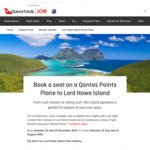Lord Howe Island +

Lord Howe Island (; formerly Lord Howe's Island) is an irregularly crescent-shaped volcanic remnant in the Tasman Sea between Australia and New Zealand, 600 km (320 nmi) directly east of mainland Port Macquarie, 780 km (420 nmi) northeast of Sydney, and about 900 km (490 nmi) southwest of Norfolk Island. It is about 10 km (6.2 mi) long and between 0.3 and 2.0 km (0.19 and 1.24 mi) wide with an area of 14.55 km2 (3,600 acres), though just 3.98 km2 (980 acres) of that comprise the low-lying developed part of the island.Along the west coast is a sandy semi-enclosed sheltered coral reef lagoon. Most of the population lives in the north, while the south is dominated by forested hills rising to the highest point on the island, Mount Gower (875 m, 2,871 ft). The Lord Howe Island Group comprises 28 islands, islets, and rocks. Apart from Lord Howe Island itself, the most notable of these is the volcanic and uninhabited Ball's Pyramid about 23 km (14 mi; 12 nmi) to the southeast of Howe. To the North lies a cluster of seven small uninhabited islands called the Admiralty Group.The first reported sighting of Lord Howe Island took place on 17 February 1788, when Lieutenant Henry Lidgbird Ball, commander of the Armed Tender HMS Supply, was en route from Botany Bay to found a penal settlement on Norfolk Island. On the return journey, Ball sent a party ashore on Lord Howe Island to claim it as a British possession. It subsequently became a provisioning port for the whaling industry, and was permanently settled in June 1834. When whaling declined, the 1880s saw the beginning of the worldwide export of the endemic kentia palms, which remains a key component of the Island's economy. The other continuing industry, tourism, began after World War II ended in 1945.
![Sydney to Lord Howe Island [Oct 4 to Early December] from $1092 Return on Qantas @ Beat That Flight](https://files.ozbargain.com.au/n/92/569092.jpg?h=885c2cc6)

